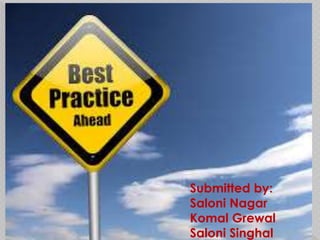Qimprolast challenge
- 1. Submitted by: Saloni Nagar Komal Grewal Saloni Singhal
- 3. ï Best practice means finding - and using - the best ways of working to achieve your business objectives. It involves keeping up to date with the ways that successful businesses operate - in your sector and others - and measuring your ways of working against those used by the market leaders Best Practice Through Benchmarking ï Applying best practice means learning from and through the experience of others. One way of doing this is through benchmarking, which allows you to compare your business with other successful businesses to highlight areas where your business could improve.
- 5. ï Know Your Suppliers ï The Compliance Oversight Committee ï Donât Let Growth Overwhelm You ï Lessons for the Compliance Practitioner
- 6. ï Its by Total Quality Control (TQC): As per this program Toyota works together with its suppliers to improve methodologies for its component products. The TQC model embedded quality into Toyotaâs production system up and down the Supply Chain. Additionally, through the program, Toyota was able to understand the critical link between quality and profit through high customer satisfaction.
- 7. ï Another key component of Toyotaâs overall quality program was a high-level oversight committee which had been set up to deal with quality issues in 2005. This oversight committee was made up of persons across functions within the company and had the power to deal with issues outside of typical bureaucratic silos. The job of this committee is not only to review and manage traditional high risk areas such as third party business representatives but a company can create such committees for other high risk issues particular to a company.
- 8. ï Once Toyota moved from traditional methodology of quality over growth as previously besides quality they were skeptical about growth also but now when they started focusing on quality, market share almost got doubled in a little spam of 10 years.
- 9. ï The growth experienced by Toyota can also be a clear lesson for the compliance practitioner. Compliance must be rigorously implemented and continued for a company to succeed in its overall anti-corruption and anti-bribery policies. The Toyota TQC model served it well until the rigor surrounding it was reduced. This model inculcated quality throughout vendors in the Supply Chain. As its rigor was reduced due to the replacing emphasis on sales, the quality of Toyotaâs product dropped. A company must continue to push compliance throughout its Supply Chain.
- 10. ï Quality control in terms education ï Enhancing the performance of students by improving quality of professors ï Full utilization of resources it being human or infrastructural ï Providing world class training to all students and its staffs ï Inculcating the importance quality rather growth in terms of students and placements
- 11. ï Lean Management ï Total Quality control ï Six Sigma implementation ï Enterprise, Resource and Planning ï Student Performance system
- 12. ï With Traditional perception we cannot change the system, firstly we need to change system in order to improve education ï Students should give opportunities in domain which they have high priorities ï Organization should focus more on quality rather than growth
- 13. Thank You












